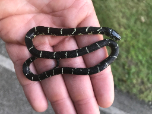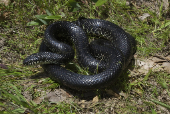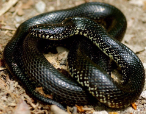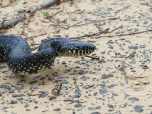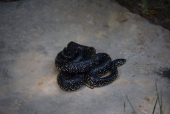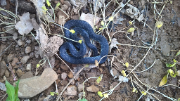Black Kingsnake (Lampropeltis nigra)
Description: The black kingsnake is a large to medium constrictor. Adult specimens attain an average size of 90 to 122 centimetres (35 to 48 in) in total length, with some reaching maximum total lengths of 58 to 72 inches. It is generally similar to L. getula, although its can be distinguished by its geography and appearance. It has a black body that is interspersed with widely spaced yellow or cream-colored speckles, larger and more numerous along the sides. The dorsum in some is unpatterned and in others crossbanded. The venter displays a checked black and yellow (or cream) pattern. Ventral scales range from 197 to 222 in both sexes, with subcaudal scales ranging from 45 to 59 in males and 37 to 51 in females.
Habitat: Black kingsnakes occupy a wide variety of habitats and are one of the most frequently encountered species by humans in some states. Preferred habitats include abandoned farmsteads, debris piles, edges of floodplains, and thick brush around streams and swamps.
Range: The black kingsnake is found in the southeastern quarter of the United States, ranging from southern Illinois to Ohio, then down along the foothills of the Appalachian Mountains and the Alabama River watershed to the northern Gulf Coast in south Alabama and along the coast to the Mississippi River in Louisiana.
Diet: Black kingsnakes prey on a variety of animals, especially reptiles and their eggs. They are known to feed on numerous species of snakes, including venomous species, and turtle eggs. They also eat small mammals, lizards, birds, and bird eggs. If prey is not swallowed immediately, it will be killed by constriction. Individuals will grab larger prey by the head and quickly constrict them.
Reproduction: he reproductive biology of this species is presumably similar to its close relative, the Speckled kingsnake, with courtship and mating in spring, eggs laid in summer, and the young hatching in late summer. Courtship and mating begin when individuals emerge from overwintering sites and continue into June. In June or July, some 3–30 eggs are likely laid in animal burrows, rotting logs or stumps, and sawdust piles. The incubation period is 56–81 days, and hatching likely occurs from August into September. Reproductive maturity is likely reached at 2–4 years of age, with males maturing earlier than females.
Status: Listed as Least Concern in view of the large extent of occurrence, large number of locations in a wide range of habitats (including altered ones), and because the species is unlikely to be declining fast enough to qualify for listing in a more threatened category.
»» Kingdom: Animalia - Animals
»» Phylum: Chordata - Chordates
»» Subphylum: Vertebrata - Vertebrates
»» Class: Reptilia - Reptiles
»» Order: Squamata - Scaled Reptiles
»» Suborder: Serpentes
»» Superfamily: Colubroidea
»» Family: Colubridae - Colubrids
»» Genus: Lampropeltis
»» Species: Lampropeltis nigra - Black Kingsnake
»» Subspecies: None
This article uses material from the Wikipedia article "Mexican black kingsnake", which is released under the Creative Commons Attribution-Share-Alike License 3.0. Content may have been omitted from the original, but no content has been changed or extended.
|


